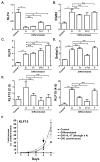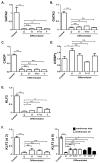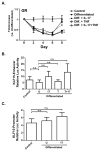IL-17 inhibits adipogenesis in part via C/EBPα, PPARγ and Krüppel-like factors
- PMID: 23332504
- PMCID: PMC3595389
- DOI: 10.1016/j.cyto.2012.12.007
IL-17 inhibits adipogenesis in part via C/EBPα, PPARγ and Krüppel-like factors
Abstract
IL-17 is an inflammatory cytokine associated with anti-microbial host defense and pathogenesis of autoimmune diseases. Obesity is considered to be an inflammatory condition, but how cytokines and fat metabolism are interconnected remains poorly understood. Mesenchymal stem cells can differentiate into adipocytes, which serve as depots for stored fat. Despite the pro-inflammatory properties of IL-17, both IL-17- and IL-17RA-deficient mice are overweight. Consistently, IL-17 suppresses maturation of cells with adipogenic potential. However, the mechanism underlying IL-17-mediated inhibition is not defined. In this study, we addressed this question by evaluating the impact of IL-17 on a variety of transcription factors (TFs) that control adipogenesis, using 3T3-L1 cells to model adipocyte differentiation. Surprisingly, IL-17 does not suppress adipogenesis via C/EBPβ and C/EBPδ, TFs often considered to be central regulators of adipogenesis. Rather, IL-17 suppresses expression of several pro-adipogenic TFs, including PPARγ and C/EBPα. Moreover, we found that IL-17 regulates expression of several members of the Krüppel-like family (KLF). Specifically, IL-17 suppresses KLF15, a pro-adipogenic TF, and enhances expression of KLF2 and KLF3, which are anti-adipogenic. Thus, IL-17 suppresses adipogenesis at least in part through the combined effects of TFs that regulate adipocyte differentiation.
Copyright © 2012 Elsevier Ltd. All rights reserved.
Conflict of interest statement
SLG received travel reimbursements from Amgen and Novartis, and a research grant from Amgen.
Figures






References
Publication types
MeSH terms
Substances
Grants and funding
LinkOut - more resources
Full Text Sources
Other Literature Sources
Miscellaneous

